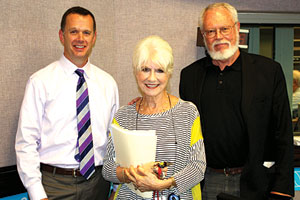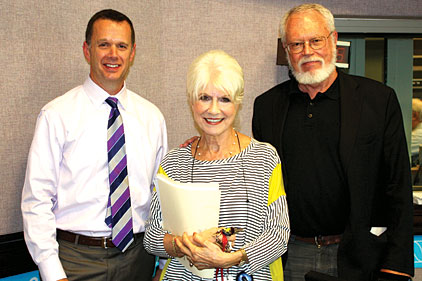
|
| Diane Rehm (center) welcomed Steve Yurek, president and CEO of AHRI (left) and Durwood Zaelke, president of the Institute for Governance and Sustainable Development (right) to the National Public Radio studios in Washington, D.C. Yurek and Zaelke were among the participants in a panel discussion on the Diane Rehm syndicated radio program which was broadcast on NPR radio stations in August. |
The article, “As Coolant Is Phased Out, Smugglers Reap Large Profits,” was written by Elisabeth Rosenthal and Andrew Lehren. It explained the problem of R-22 refrigerant smuggling and reported on the trial and conviction of an executive who was smuggling R-22 at a large parts distributor based in St. Louis. However, the article’s authors also blamed air conditioning manufacturers for being part of the smuggling problem.
The article stated: “International efforts to curb the use of HCFC-22 are faltering for dozens of reasons, from loopholes in environmental treaties to the reluctance of manufacturers to step up development of more environmentally friendly machines.”
In response, Steve Yurek, AHRI president and CEO, said, “All U.S. manufacturers had equipment available in the market that used non-ozone depleting refrigerants for over a decade before the January 2010 phaseout of R-22 required by the Montreal Protocol and implemented by the Environmental Protection Agency (EPA).”
Additionally, the New York Times article charged that the continued production by manufacturers of dry-ship R-22 units has added to the smuggling problem. The article included the following statement: “Many air conditioning manufacturers have even figured out how to sidestep the 2010 ban on selling new machines containing HCFC-22, by offering unfilled air conditioning compressors that service workers swap into existing units and then fill with the gas, creating refurbished machines that are as good as new.”
AHRI noted in response that the EPA rules did not contain a complete ban on the manufacturing of new equipment using R-22, but allowed continued production of R-22 equipment as long as it was not charged with R-22 until installed in the field. AHRI and its members petitioned EPA to remove this provision and ban the manufacture of new equipment using R-22, but the agency has not acted on this request and the provision remains.
Yurek said, “The New York Times article’s implication that manufacturers are to blame is wrong and misdirected. There are thousands of products available in the market that contain non-ozone depleting refrigerants at efficiency levels at and significantly higher than the federal minimums. The demand for R-22 equipment cannot be laid at the feet of manufacturers.”
He added, “If the EPA rules had been released in a timely manner and if the EPA had banned the manufacture of new equipment using R-22 as everyone intended and expected, this situation would not exist today.”
Yurek also defended manufacturers from the article’s implication that they violate U.S. law to ensure greater access to R-22. “It is outrageous for the New York Times to suggest, without a shred of evidence, that manufacturers are in any way involved with the use of smuggled refrigerants,” he said. “Our member companies have always strictly abided by U.S. law and will continue to do so. Any allegation to the contrary is completely without merit.”
The article characterized the problem of smuggling as serious and unchecked. According to the authors, “The gas is still produced in enormous volumes and sold cheaply in China, India and Mexico, among other places in the developing world, making it a profitable if unlikely commodity for international smugglers.”
When asked about the level of smuggling of R-22 in the U.S., Yurek said, “It is an issue — we don’t deny that, and we are actively working with federal law enforcement to make smuggling more difficult and easier to detect.” As further restrictions on the manufacture of R-22 go into effect in 2015, the problem could get worse. At that time, production will be reduced by 90 percent from base levels established in 1989. In 2020, production will be further reduced to 99.9 percent.
Refrigerant producers and re-sellers are aware of the potential for smuggling and are also addressing the issue. Maureen Beatty, vice president of operations for National Refrigerants Inc., said, “Smuggling is an issue, but the industry has past experience dealing with it based on CFCs and their phaseout. Collectively, the industry and government agencies are smarter now and are putting forward a collective effort to prevent these things from happening.”
Beatty also provided a couple of rules of thumb for contractors to avoid buying smuggled refrigerant. If the price is too good to be true, she said, then a contractor should start to ask questions. Also, she recommended that contractors align themselves with reputable wholesale companies that carry name brand suppliers.
Publication date: 10/8/2012


Report Abusive Comment